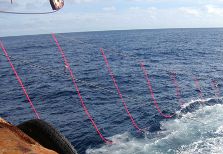Warp strike mitigation devices in New Zealand fisheries
Published:
April 2013This research report is the final output from CSP project 'MIT2011-07 Warp strike mitigation devices in use on trawlers > 28 m in length operating in New Zealand fisheries'.
This is a project to improve warp strike mitigation devices in use on trawlers > 28 m in length operating in New Zealand fisheries.
Download the publication

Tori line deployed on a trawler
Summary
The use of devices that aim to reduce seabird strikes on trawl warps has been required on New Zealand trawlers > 28 m in overall length since April 2006. Seabirds may strike, or be struck by trawl warps while feeding opportunistically astern trawl vessels. These strikes can cause injury or death.
We examined two of the three legally-specified seabird scaring devices - paired streamer lines and bird bafflers - with the aim of improving their design, construction, durability, and ultimately performance and efficacy at sea. For bafflers, we also sought to use existing data to compare the efficacy of 2- and 4-boom designs.
At-sea trials of streamer line materials were conducted on a deepwater trawler 105 m in length, using midwater gear. These trials produced clear recommendations on streamer line materials and construction. Of the four tested, the best-performing streamer material was Kraton. The optimal configuration for streamers involved direct attachment (i.e., interweaving streamers into the backbone and not using clips or swivels) at 3 m intervals along the backbone of the streamer line. The best-performing terminal object of the five tested was a trawl float 360 mm diameter and 9.1 kg in weight. This could be replaced by a 6.5 kg trawl float of the same diameter on vessels with lower block height. Deploying a terminal object of 1.2 kg for every 1 m of vessel block height is recommended. Amongst the 30 – 60 m lengths tested, a backbone of 30 m almost always performed best. Deploying 5 m of backbone for every 1 m of vessel block height is recommended. These recommended design specifications have been captured in a fact sheet, and promulgated amongst the deepwater trawl fleet.
For bafflers, a step analysis showed that processing waste discharge is consistently more important in determining the prevalence of trawl warp strikes than whether these devices comprised two or four booms. However, the data available were insufficient to support more in-depth modelling. Drawing on the design, construction and performance features of bafflers currently deployed in the fleet, an improved baffler design is proposed. Further work comparing the performance of bafflers of different designs quantitatively is also recommended.
Publication information
Report prepared by John Cleal (F.V. Management Services Ltd), Johanna P. Pierre (JPEC Ltd) and George Clement (Clement and Associates Ltd) for the Department of Conservation
Contact
Conservation Services Programme
Department of Conservation
PO Box 10-420
Wellington 6143
New Zealand
Email: csp@doc.govt.nz
